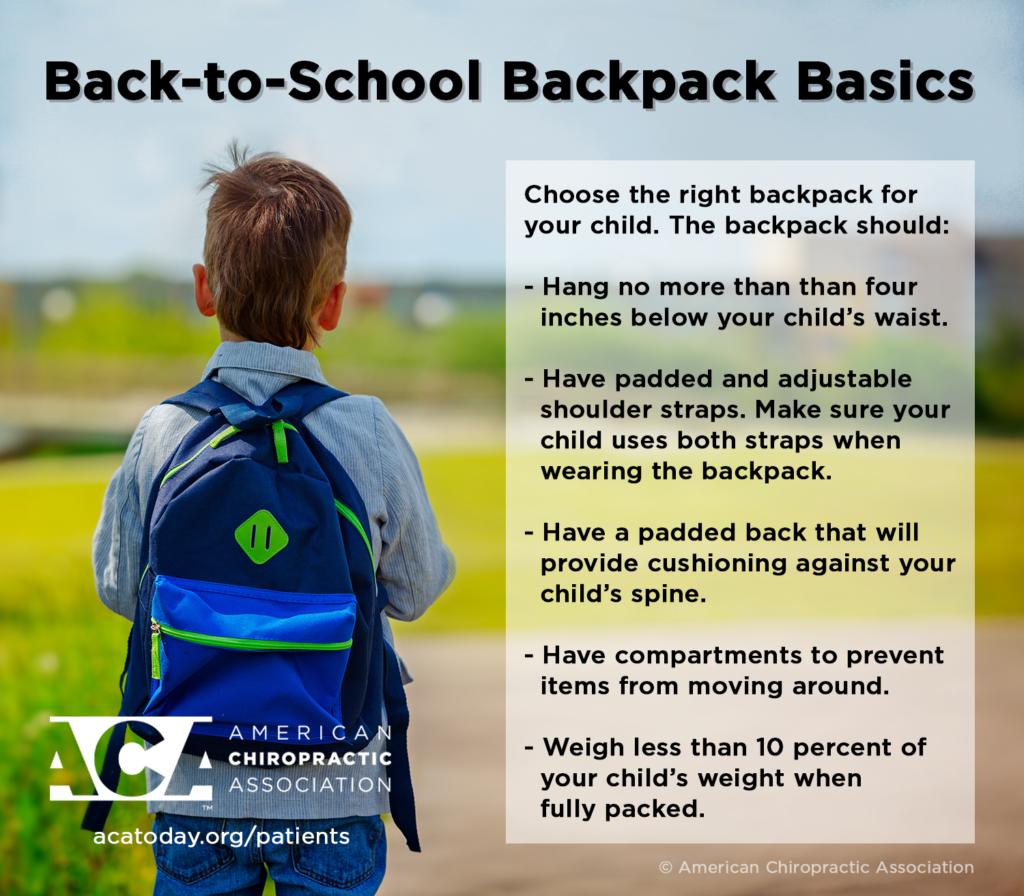Arlington, Va.—It’s that time of year again: Parents are buying their children supplies for the upcoming school year, but what they may not realize is that one item on their list is sending thousands of children to doctors’ offices every year—backpacks.
In fact, statistics from the Consumer Products Safety Commission show that in 2017 an estimated 7,800 kids between 5-18 years old were treated in emergency rooms for injuries related to backpacks.
According to Scott Bautch, DC, president of the American Chiropractic Association’s Council on Occupational Health, many students experience back, neck and shoulder pain from oversized and overstuffed backpacks. “With the combination of carrying backpacks much too heavy for a child’s physical abilities and an increasing sedentary lifestyle, children are reporting back pain at similar rates as adults,” Dr. Bautch explains.
To help ensure students in your household avoid backpack-related pain, consider the following tips from the American Chiropractic Association (ACA):
- Choose the right size. Bigger is not necessarily better; the more room there is in a backpack, the more your child will carry and the heavier the backpack will be. The backpack should never hang more than four inches below your child’s waistline, as this increases weight on the shoulders and causes the child to lean forward when walking.
- Look for wide, padded and adjustable shoulder straps. Nonpadded straps are uncomfortable and can dig into your child’s shoulders. The straps should be adjustable so the backpack can fit your child’s body. Straps that are too loose can cause the backpack to dangle, causing spinal misalignment and pain.
- Urge your child to wear both shoulder straps. Lugging the backpack around by one strap can cause a disproportionate shift of weight to one side, leading to neck and muscle spasms, as well as low back pain.
- Look for a backpack with compartments. Having individual compartments for smaller items helps in positioning contents more effectively. Pack pointy or bulky objects away from the area that will rest on your child’s back.
- Check the weight of the backpack. Make sure your child’s backpack, when fully loaded, weighs no more than 10 percent of their total body weight. A heavier backpack will cause your child to bend forward to support the weight on the back, rather than the shoulders.
If your child experiences any pain or discomfort resulting from backpack use, contact a doctor of chiropractic. Chiropractors are trained and licensed to diagnose and treat patients of all ages and will use a gentler type of treatment for children. They use a hands-on, non-drug approach to address common musculoskeletal conditions such as back pain, neck pain, pain in the joints of the arms or legs, and headaches. Chiropractors are also trained to recommend therapeutic and rehabilitative exercises, and to provide dietary and lifestyle counseling. To find an ACA chiropractor near you, visit www.acatoday.org.
About the American Chiropractic Association
The American Chiropractic Association (ACA) is the largest professional chiropractic organization in the United States. ACA attracts the most principled and accomplished chiropractors, who understand that it takes more to be called an ACA chiropractor. We are leading our profession in the most constructive and far-reaching ways—by working hand in hand with other health care professionals, by lobbying for pro-chiropractic legislation and policies, by supporting meaningful research and by using that research to inform our treatment practices. We also provide professional and educational opportunities for all our members and are committed to being a positive and unifying force for the practice of modern chiropractic. To learn more, visit www.acatoday.org and connect with us on Facebook and Twitter.
###
